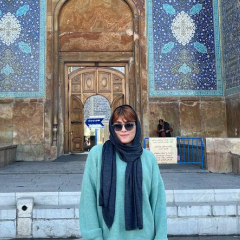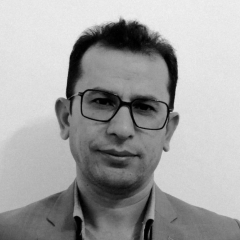رزومه
تحصیلی
دیپلم High School Diploma , Math از دبیرستان Ilam (1380 تا 1381)
کارشناسی Bachelor of Science , Petroleum engineering - Hydrocarbon Reservoirs Engineering از دانشگاه Omidieh (1383 تا 1387)
کارشناسی ارشد Masters degree , Chemical Engineering - Process Design از دانشگاه Ahar (1391 تا 1393)
مقالات
" Evaluation of recovery reduction problem from oil and gas fields due to liquid accumulation in gas wells and presenting improvement methods" در May 12, 2015 publication description1st National Conference on Petroleum Geomechanics, International Convention Center of RIPI Tehran, May,12-14,2015. (1394)
Liquid drops and gas flow in ground reservoir increase complicacy of computing minimum gas flow rate to extract the liquids from the well. Gravity force lead the drops downward and tension force of gas lead them upward. When these two forces are equal, the drops float and the gas flow rate is called critical flow rate. When gas flow is critical, the drops float, and over the critical rate, the drops glide upward and downward when the flow rate is less than critical value. In general, critical flow rate is the minimum gas flow that is not capable of bringing the liquid to the surface and form a column of liquid in the well and reduce yield of the well. To prevent concentration of liquid, gas flow rate needs to be kept at critical level. Neural network and transient two-phase model were used to survey and detect concentration of liquid in gas well. The results help us to avoid concentration of liquid by monitoring minimum rate of gas flow and injection gas. The first section introduces a multilayer perceptron neural network and the proposed model to predict concentration of liquids. Section two deals with the modeling equations of transient two-phase flow ruling concentration of liquids in the form of numerical extension. The surveys and predicted minimum flow rate showed that critical rate error in the neural and transient two-phase models are trivial and the results were acceptable.
" pattern effect analysis of the injection and production wells on gas injection process with considering geological information and reservoir properties in a petroleum field" در May 12, 2015 publication description1st National Conference on Petroleum Geomechanics, International Convention Center of RIPI Tehran, May,12-14,2015. (1394)
Study site was divided into four sectors and the sector under study was 3.5 and 3.2km in length and width respectively and 150m deep. The site was an oil field of quality oil with API of 36. Preliminary pressure of the reservoir was 5300psi with fracture of 18-23% and permeability of 0.38-3MD. At early phase of production, the reservoir was in hyper-saturation condition and over time production rate has decreased. Because of this, the field has gradually developed saturation condition and gas dome has formed. The required information to develop the statistic model of an oil reservoir include geological information (stratus structure, surfaces, and faults),petro-physical information (fracture, relative and absolute permeability, and effective thickness to total thickness rate),engineering information of the reservoir (position of wells, real and vertical depth of the wells, and VFP data). The purpose of the analysis is to detect behavior of reservoir relative to changes of the parameters. The results will be used to predict future behavior of the reservoir based on the parameters and performance of gas injection in the reservoir. The present article tires to evaluate the effect of patterns of injection and production wells on performance of gas injection process. To this end, main patterns (4 spot, 4 spot-dual, 5 spot, 5 spot-dual) and their effect in increasing oil and gas reservoir yield were evaluated. It is notable that number of injection and production wells was different for each model. The experiments showed that 5 Spot-Dual pattern was the optimum pattern for our model, and it was taken into account for other scenarios.
" Evaluation of Immiscible Injection Process of Water and Gas to Increase Oil Recovery in Dorood Field" در May 12, 2015 publication description1st National Conference on Petroleum Geomechanics, International Convention Center of RIPI Tehran, May,12-14,2015. (1394)
Great deal of oil reservoir remains in rock matrix during extraction of oil from hydrocarbor reservoir. Modern technology and science of engineering enables us improve oil extraction up to 30 to 50%. Gas and water injection increases oil production from the matrix via gravity drainage. The purpose of injecting gas or water into oil reservoir is to supply and increase pressure of the reservoir. The operation induces changes in thermodynamic properties of oil reservoir including saturation pressure, formation volume index, viscosity, and specific weight of oil. No reaction is triggered between injected material and the hydrocarbons throughout immiscible injection so that the two elements remain in different phases. Oil current mechanism with this type of injection is increase of generated pressure by the injection material. The present study is an attempt to survey the effect of injecting water and gas on stimulating oil wells and response of the wells in Dorood. Taking into account studies carried out at the site, it is concluded that one effective and reliable way of increasing oil production is to keep the pressure by immiscible injection of oil and gas. Economically speaking and given easy access to water and gas at the region, the injection operation leads to 10% increase of oil production, which means more than 800 million extra barrel of oil.
" Efficiency evaluation of various gases injection in order to enhance oil recovery (EOR) in Iranian southwestern fractured carbonate reservoir" در May 12, 2015 publication description1st National Conference on Petroleum Geomechanics, International Convention Center of RIPI Tehran, May,12-14,2015. (1394)
From geomechanical viewpoint, fractures in carbonated reservoirs are formed by solid surface with low adhesive properties under pressures of tectonic forces by different types of rocks. fracture model of fractured reservoirs is formed by matrix. Interparticle porosity (like common fracture in porous environment) and fracture porosity are usually known as secondary fracture, which is empty space or fracture. The preset paper is an attempt to survey and compare different scenarios of nitrogen, carbon dioxide and nitrogen, and carbon dioxide injection. The results showed that gas recovery outperformed injection of other types of gasses. The reason is that in addition to higher increase oil oil production comparing with other methods, easier access to the required gas cuts the cost of the operation to a great extent. Following natural gas, other types of gases also increased oil production based on their miscibility pressure. That is, the lower the miscibility pressure, the higher oil
production increase.
" Use of nano technology in enhancement of recovery from oil and gas reservoirs" در May 12, 2015 publication description1st National Conference on Petroleum Geomechanics, International Convention Center of RIPI Tehran, May,12-14,2015. (1394)
Oil and gas are the two main sources of fuel in our modern societies. Given limited oil and gas resources and man’s limitation in exploring and extracting hydrocarbor resource, developing new technologies to increase extraction from gas and oil resource seems inevitable. New nano technologies are promising opportunities to make considerable changes in different fields of gas and oil production. A short introduction to standard and conventional extraction and improvement of extraction is given in what followed and new opportunities provided by nano technology in different aspects are explained later. The authors believe that nano technology and new approaches to layout, structure, and material properties in oil and gas industry can solve many of current issues. The paper is aimed at surveying effects and performance of nano technology on the operation of increasing yield of oil and gas reservoirs in four key fields of nano-fluids, nano particles, nano surfactant, and nano composite hydrogels. Nano fluids induce wettability changes, decrease of strain force, and increase of strength of sand. Among applications of nano particles, facilitating oil and gas separation inside the reservoir and nano-trackers in the rock of reservoir are notable. Nano surfactants cut surface strain, improve wettability, reduce permeability pressure at reservoir fracture section. Hydrogels are hydrophilic three dimensional polymer composites that expand in presence of water while remaining unsolved. With viscosity equal with water, the gel can be injected into the reservoir using conventional pumps and given identical structures with water, penetration of gel is higher than that of cement. The results of the surveys and the experiments can considerably increase in site recover of reservoir.
" Evaluation of Driller`s and Wait and Weight Methods in the Well Killing Operations" در The 5th. International Chemical and Petroleum Engineering ,Tehran , Iran , 15 May 2019 (1398)
With today`s search for more and remote black gold, drilling gets deeper along with more complex well paths which reduces the margins for errors. This increases focus and requirements to personnel`s experience and knowledge, and are one of the most important factor in terms of reducing the risk and consequence if an incident should happen. After taking a kick a well control situation has occurred. In order to regain well control there are established several methods that can be used to regain well control. Driller`s method is a two circulation method. After a kick is taken and the BOP is closed, the pressures in the annulus and drill pipe are read and written down. Based on these pressures new kill mud can be weighted up, the main purpose of the new mud is to balance the formation pressure after the kick has been circulated out of the well. In the first circulation stage inflow fluid is circulated out of the well. Since the BOP is closed the return flow has to go through the choke line, which is a line on the outside of the riser and up to surface. At the end of the choke line there is placed a choke valve. This can be regulated between open and closed position. The choke enables regulation which is used to hold and maintain a constant bottom hole pressure during the entire kill operation. The bottom hole pressure is kept equal to the pore pressure plus a safety margin to make sure the pressure is above the formation pressure. The second circulation stage is when the new kill mud is introduced to the well and circulated down the drill pipe and up annulus. After the second stage, the entire well is filled with new kill mud and it is now able to balance the formation pressure on its own and drilling can proceed as intended before the kick started. The Wait and Weight (W&W) method is also known as the one circulation method. When a kick is taken and BOP has been closed, pressures are noted, and new kill mud is pumped simultaneously as the kick is circulated out. This is different from Driller`s method that uses two circulation stages, the first to get the kick out of the well using old mud and the second to replace old mud with new kill mud. The Driller`s method and the W&W method uses the same choke line with the ability to regulate the choke. The goal is to maintain a constant bottom hole pressure between the formation and fracture pressure window. With this method it is more difficult to carry out the operation as the columns in both drill pipe and annulus will change as kill process is carried out. For the Driller`s method (DM) and Weight and Wait (W&W) method, in many ways they use the same operational procedures when killing the well, but the thing that separates them from each other are when kill mud gets introduced into the system. Time consumption are also another aspect that separates them, where W&W uses less time compare to DM. W&W can also have an positive advantage, if the kill mud enters the annulus before the kick reaches the casing shoe, then it will be able to reduce the pressure from the kick acting on the casing shoe due to its heavier weight. If the casing shoe has a good quality then the Driller`s method should be the chosen method. The shoe will in DM be exposed to large pressures for a longer time period compare to W&W. Also if it takes a long time to weight up kill mud the DM should be used. One intention with this paper is to shed light on different elements related to well control, in this way it is possible to increase the overall understanding a bit more. The second intention with the paper is to give a broader understanding of two well control methods used today.Hopefully the paper will contribute to a broader understanding of well control.
"The Analysis of Safety Methods on the Well in Controlling Eruption Operations of Hydrocarbon Reservoirs ." در ,The ninth International Conference on Oil , Gas , Refining & Petrochemical With Focus Relationship Between Government, University and Industry, Shiraz, Iran ,20 June 2019 (1398)
"The Optimization of Drilling Operations with using Pressure Profile Analysis." در The 3rd. International Conference on Oil, Gas, Petrochemical and HSE, Hamedan, Iran, January 10, 2019. (1398)
"The Evaluation of Stuck Mechanism in Excavation Pipes under the Difference Pressure Level Between Fluid Wall and Formation." در The 3rd. International Conference on Oil, Gas, Petrochemical and HSE, Hamedan, Iran, January 10, 2019. (1398)
"The Investigation of Injecting Vapor to Cracked Carbonate Reservoirs to Increase the Oil Recovery rate." در The 3rd. International Conference on Oil, Gas, Petrochemical and HSE, Hamedan, Iran, January 10, 2019. (1398)
"Evaluating the Impression of Toxic Material from Gas Liquidities on Enviroment and Presenting a Structural Method to Elimination of the Hydrocarbon Contaminents." در The 3rd. International Conference on Oil, Gas, Petrochemical and HSE, Hamedan, Iran, January 10, 2019. (1398)
"Qualified Secure Investigation to Modify Current Systems." در 3nd. National Conference on Oil, Gas and Petrochemials, Gachsaran, Iran, March, 4-5 , 2014. (1393)
مهارت ها
"Oil and Gas Drilling Industry Skills" در سطح پیشرفته
1. Hoisting System
2. Rotating System
3. Circulating System
4. Controlling System
5. Power & Drive System
6. Monitoring System
"Other Petroleum Skills" در سطح پیشرفته
1. ( Enhance Oil Recovery ( EOR
2. Well Testing
3.Reservoir Engineer : Updating reservoir models and characteristics by gathering the latest data such as petrophysical log evaluations, core and PVT data, fluid pressures, well tests, production data and geological data for assessment and modification of reservoir performance.
4. Modeling Transport Phenomena Using Different Software
5. Integration and Process Design - Optimized Heat Exchanger - Fuel Cells
6. Design Reactor and Modeling of Catalytic Processes - Thermodynamics of Phase Equilibriums
زبان های خارجه
"English" در سطح پیشرفته
طرح های پژوهشی
طرح " Enhanced Oil Recovery Project in Dorood Field ( Production Performance & Observations ) Feb 2011 " در ( Iranian Offshore Oil Company ( I O O C (1390)
Production Performance
Observations :
1. Increase in W.C.% mainly due to depletion of Manifa and sharp production decline (i.e. Wells D-101P,D-102P,KG-31,KG-34,D-130P,KG-17,KG-18).
2. Reservoir Pressure Decline especially in Yamama Reservoir( from 5800 to 3500 Psi).
3. Increase in Production GOR due to Pressure Decline.
طرح " Enhanced Oil Recovery Project in Dorood Field ( YAMAMA & MANIFA Case Study ) Nov 2011 " در ( Iranian Offshore Oil Company ( I O O C (1390)
( DOROOD FIELD ( YAMAMA - MANIFA
1. Extrados faults, Large throw in the North, Limited throw in the South.
2. Total thikness Yamama + Manifa : 300 m.
3. Several identified permeability barriers in various Locations.
4. Upper YAMAMA ( H = 100 m ) Low permeability # 1 mD.
5. Middle YAMAMA ( H = 150 m ) Low permeability +/- 0.5 - 5 mD. With high permeability streaks ( 10 - 100 mD ).
6. MANIFA ( H = 50 m ) High permeability ˃ 100 mD.
7. one FWL at -3675 m/msl Two different WOC Yamama : -3633 , Manifa : -3675 .
8. Evaluation of Current oil Saturation in Yamama.
9. Evaluation of Current oil Saturation in Manifa.
طرح " Enhanced Oil Recovery Project in Dorood Field ( Production Performance & Solutions ) Jul 2012 " در ( Iranian Offshore Oil Company ( I O O C (1391)
Production Performance
Solutions :
1. Changing well completion interval into Yamama and Asmari Reservoirs. wells KG-33, KG-43, KG-14, KG-17, KG-31,KG-34,D-130P,KG-17,KG-18 and all offshore wells.
2. Necessity of pressure Maintenance with Water/Gas injection. Secondary Recovery Mechanism has been started with water and gas injection at nominal rate of 250 MSTBD and 120 MMSCFD Respectively).
3. Utilizing Artificial lifting System for production enhancement in wells with high water cut. A gas kick-off project has been started to be used for temporary lifting of problematic wells and/or flowing new drilled wells.
طرح " Enhanced Oil Recovery Project in Dorood Field ( Water Injection System ) Aug 2013 " در ( Iranian Offshore Oil Company ( I O O C (1392)
Water Injection System
1. 12 Injection Wells
2. Nominal Injection Rate: 250 MSTBD
3. Average Actual Injection Rate: 235 MSTBD
4. Requested Pressure: At onshore injection well heads: 235 bar abs.
طرح "Enhanced Oil Recovery Project in Dorood Field ( Evaluation of water injection Performances ) Oct 2013 " در ( Iranian Offshore Oil Company ( I O O C (1392)
Evaluation of water injection Performances
1. North and Center of the reservoir are main targets of Water injection System.
2. It’s been observed considerable decline in production GOR in several wells after injection. It means pressure enhancement during Injection.
3. Manifa Injection Interval Would be excluded from Perforation Interval in injection wells in next few years due to depletion of Manifa.
4. Seawater characteristics at the lift station is expected to have the following properties :
- Required Quality :
- Source : Seawater.
- Residual particle : < 2 mm (The fine filters shall remove 98% of all particles greater than 2 microns).
- Oxygen Content : < 30 ppb @ 37 °C.
طرح " Enhanced Oil Recovery Project in Dorood Field ( Gas injection System ) Mar 2014 " در ( Iranian Offshore Oil Company ( I O O C (1393)
Gas injection System
1. 2 Injection Wells
2. Nominal Injection Rate: 120 MMSCFD
3. Average Actual Injection Rate: 115 MMSCFD
4. Design Gas Injection Flow Rate per Well:65 MMSCFD
5. Center of the field is main target of Gas injection System.
طرح " Enhanced Oil Recovery Project in Dorood Field ( Evaluation of Gas injection Performances ) Jul 2014 " در ( Iranian Offshore Oil Company ( I O O C (1393)
Evaluation of Gas injection Performances
1. It’s been observed considerable decline in production GOR in several wells after injection. It means pressure enhancement during Injection.
2. Fluid Composition ( composition of injection Gas ) : The composition of injection gas, for two light and heavy cases at the compressor discharge, in mole % is shown below :
Component----------------------Light Case-----------------------Heavy Case
C1--------------------------------------71.09--------------------------------62.78
C2--------------------------------------9.36----------------------------------8.62
C3--------------------------------------3.66----------------------------------3.93
iC4--------------------------------------0.50----------------------------------0.64
nC4-------------------------------------0.95----------------------------------1.33
iC5--------------------------------------0.36----------------------------------0.58
nC5-------------------------------------0.56----------------------------------0.94
nC6-------------------------------------0.17----------------------------------0.29
nC7-------------------------------------0.07----------------------------------0.09
nC8-------------------------------------0.02----------------------------------0.02
nC9-------------------------------------0.0------------------------------------0.0
nC10-----------------------------------0.0------------------------------------0.0
CN1A----------------------------------0.0------------------------------------0.0
CN1C----------------------------------0.0------------------------------------0.0
CN12-----------------------------------0.0------------------------------------0.0
N2---------------------------------------0.0------------------------------------1.71
H2S-------------------------------------6.51----------------------------------11.60
CO2-------------------------------------6.74----------------------------------7.47
طرح " Enhanced Oil Recovery Project in Dorood Field ( Production Fluid & Average temperature of the production fluid ) Jul 2014 " در ( Iranian Offshore Oil Company ( I O O C (1393)
Production Fluid
Fluid Composition :
1. The composition of production fluid for three Gas to Oil Ratios (GOR) in mole percent dry basis is :
Component----------GOR=1850----------GOR=2400----------GOR=3000
H2S---------------------9.490-----------------7.615---------- ------7.76
CO2---------------------5.435-----------------5.174----------------5.27
C1-----------------------43.511----------------51.149--------------53.67
C2-----------------------6.6---------------------8.602----------------9.03
C3-----------------------3.662------------------3.86------------------3.76
iC4----------------------0.791------------------0.728-----------------0.71
nC4---------------------1.890------------------2.014-----------------1.96
iC5-----------------------1.401------------------0.772----------------0.70
nC5----------------------2.776------------------1.053----------------0.56
nC6-----------------------2.455------------------2.256----------------2.05
nC7-----------------------2.943-------------------2.476---------------2.14
nC8-----------------------2.125 -------------------1.78-----------------1.55
nC9-----------------------1.486--------------------1.249---------------1.08
nC10----------------------1.204--------------------1.011---------------0.88
CN1A----------------------4.165--------------------2.732--------------2.23
CN1C----------------------8.131--------------------5.5475-------------4.53
CN12----------------------0.772--------------------1.7262-------------1.45
N2--------------------------1.63---------------------0.2552-------------0.27
2. Average temperature of the production fluid is 70°C. Estimated range of flowing temperature at production wellhead is 60-95°C.
نرم افزار ها
نرم افزار "Eclipse 100 & 300" در سطح پیشرفته
نرم افزار "( CFD ( Fluent & Gambit " در سطح پیشرفته
نرم افزار "Hysys" در سطح پیشرفته
نرم افزار "Matlab" در سطح پیشرفته
توجه: اطلاعات روزمه افراد بر اساس اظهار خودشان است و مورد راستی آزمایی قرار نگرفته است.





 مدا
مدا  Kian.va
Kian.va  melikarash
melikarash  rozhe
rozhe  ehsan31.t
ehsan31.t  elienaz.mdi
elienaz.mdi  mesdagh_zr
mesdagh_zr  جواد حمودی ۱۴۰۴/۰۶/۰۱
جواد حمودی ۱۴۰۴/۰۶/۰۱ Kian.va ۱۴۰۴/۰۴/۱۴
Kian.va ۱۴۰۴/۰۴/۱۴ Mabzg ۱۴۰۴/۰۲/۰۶
Mabzg ۱۴۰۴/۰۲/۰۶ azizi8525 ۱۴۰۴/۰۲/۰۴
azizi8525 ۱۴۰۴/۰۲/۰۴ Farhad Mirzabaghi ۱۴۰۴/۰۱/۱۸
Farhad Mirzabaghi ۱۴۰۴/۰۱/۱۸ Willi ۱۴۰۴/۰۱/۱۳
Willi ۱۴۰۴/۰۱/۱۳ مدا ۱۴۰۴/۰۱/۱۱
مدا ۱۴۰۴/۰۱/۱۱ rozhe ۱۴۰۳/۱۱/۱۹
rozhe ۱۴۰۳/۱۱/۱۹ ehsany81 ۱۴۰۳/۰۹/۰۴
ehsany81 ۱۴۰۳/۰۹/۰۴ sajadfarahani ۱۴۰۳/۰۷/۰۷
sajadfarahani ۱۴۰۳/۰۷/۰۷